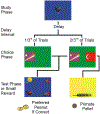Explicit memory and cognition in monkeys
- PMID: 31917205
- PMCID: PMC8719341
- DOI: 10.1016/j.neuropsychologia.2019.107326
Explicit memory and cognition in monkeys
Abstract
Taxonomies of human memory, influenced heavily by Endel Tulving, make a fundamental distinction between explicit and implicit memory. Humans are aware of explicit memories, whereas implicit memories control behavior even though we are not aware of them. Efforts to understand the evolution of memory, and to use nonhuman animals to model human memory, will be facilitated by better understanding the extent to which this critical distinction exists in nonhuman animals. Work with metacognition paradigms in the past 20 years has produced a strong case for the existence of explicit memory in nonhuman primates and possibly other nonhuman animals. Clear dissociations of explicit and implicit memory by metacognition have yet to be demonstrated in nonhumans, although dissociations between memory systems by other behavioral techniques, and by brain manipulations, suggest that the explicit-implicit distinction applies to nonhumans. Neurobehavioral studies of metamemory are beginning to identify neural substrates for memory monitoring in the frontal cortex of monkeys. We have strong evidence that at least some memory systems are explicit in rhesus monkeys, but we need to learn more about the distribution of explicit processes across cognitive systems within monkeys, and across species.
Keywords: Implicit; Memory monitoring; Memory systems; Metacognition; Monkey; Primate; Tulving.
Copyright © 2019. Published by Elsevier Ltd.
Figures





References
-
- Baddeley, 2003. Working memory: looking back and looking forward. Nat. Rev. Neurosci 4 (10), 829–839. - PubMed
-
- Baddeley, Hitch, 1974. Working memory. In: Bower GH (Ed.), Psychology of Learning and Motivation, vol. 8. Academic Press, pp. 47–89.
Publication types
MeSH terms
Grants and funding
LinkOut - more resources
Full Text Sources
Other Literature Sources
Medical
Miscellaneous

